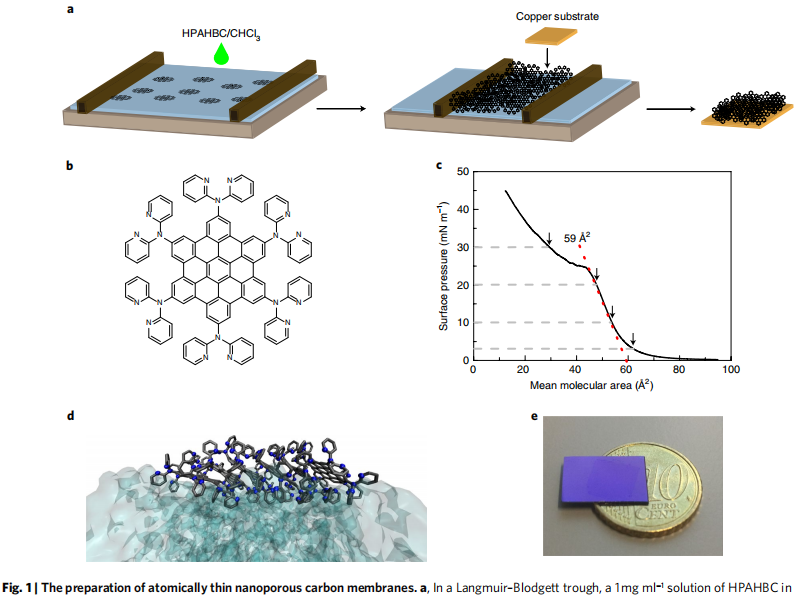博文
新的碳膜发电能力提高了一百倍(附原文)
|||
新的碳膜发电能力提高了一百倍(附原文)
诸平


据荷兰莱顿大学(Leiden University)2020年3月10日提供的消息,莱顿大学的化学家们创造了一种只有一个分子厚的新型超薄膜。该膜可从海水中产生能量,而且是当今使用的最佳膜的一百倍。研究人员于2020年3月9日在《自然纳米技术》(Nature Nanotechnology)杂志上发表了他们的发现——Xue Liu, Meng He, Dario Calvani, Haoyuan Qi, Karthick B. Sai Sankar Gupta, Huub J. M. de Groot, G. J. Agur Sevink, Francesco Buda, Ute Kaiser, Grégory F. Schneider. Power generation by reverse electrodialysis in a single-layer nanoporous membrane made from core–rim polycyclic aromatic hydrocarbons, Nature Nanotechnology, Published: 09 March 2020, DOI: 10.1038/s41565-020-0641-5.
参与此项研究的还有来自德国乌尔姆大学(Ulm University)的研究人员。
薄而多孔的新膜
当淡水和盐水汇合时,盐和其他颗粒会发生交换。置于水中的膜能够利用从一侧移动到另一侧的粒子的能量。也可以使用类似的方法来淡化海水。莱顿大学的化学家们已经开发出一种新的膜,其产生的能量(67 W/m2)是经典膜和科学文献中已知的原型膜的一百倍。
产生多少能量取决于膜的厚度和多孔性。研究人员能够制造出既多孔又薄的碳基膜。这就是为什么它比目前的多孔或薄膜,但不能同时具有两者的膜能产生更多能量的原因。
为了制造这种新的膜,刘学(Xue Liu音译)和格雷戈里·施奈德(Grégory Schneider)将大量油性分子散布在水面上。然后,这些分子构件自行形成薄膜。通过加热薄膜,分子被锁定在适当的位置,从而形成稳定且多孔的膜。根据刘学的说法,该膜可以适应特定要求。刘学说:“我们创建的膜只有两纳米厚(实际厚度为2.0±0.5 nm,孔径大小为3.6±1.8 nm),并且对钾离子具有渗透性。我们可以通过使用不同的分子构件来改变膜的性质,以适应不同的任何需求。”
石墨烯
新的碳膜类似于石墨烯,后者是仅由碳原子组成的大型扁平膜。但是根据格雷戈里·施奈德的说法,这种新膜属于另一类。格雷戈里·施奈德说:“制造膜时,许多研究人员从非常薄但不多孔的石墨烯开始。然后,他们尝试在膜上打孔以提高渗透性。我们通过组装小分子和用这些分子构建更大的多孔膜。与石墨烯相比,它具有缺陷,但这就是它的特殊性能。”
这种新型膜结合了两者的优点。格雷戈里·施奈德说:“该领域的许多研究都集中在制造更好的催化剂上,膜几乎是死胡同。这一新发现为发电、脱盐和制造更高效的燃料电池打开了全新的可能性。”更多信息请注意浏览原文或者相关报道。
Water desalination picks up the pace
Scientists use carbon nanotube technology to develop robust water desalination membranes
Abstract
Nanoporous graphene and related atomically thin layered materials are promising candidates in reverse electrodialysis research owing to their remarkable ionic conductivity and high permselectivity. The synthesis of atomically thin nanoporous membranes with a narrow pore size distribution, however, remains challenging. Here, we report the fabrication of nanoporous carbon membranes via the thermal crosslinking of core–rim structured monomers, that is, polycyclic aromatic hydrocarbons. The mechanically robust, centimetre-sized membrane has a pore size of 3.6 ± 1.8 nm and a thickness of 2.0 ± 0.5 nm. When applied to reverse electrodialysis, the nanoporous carbon membrane offers a high short-circuit current with an output power density of 67 W m−2, which is about two orders of magnitude beyond that of the classic ion-exchange membranes and current prototype nanoporous membranes reported in the literature. Crosslinked and atomically thin porous polycyclic aromatic hydrocarbon membranes therefore represent new scaffolds that will revolutionize the rapidly developing fields of sustainable energy and membrane technology.
https://wap.sciencenet.cn/blog-212210-1222928.html
上一篇:撤稿四大教训
下一篇:红树林在防洪中的保护作用不可低估